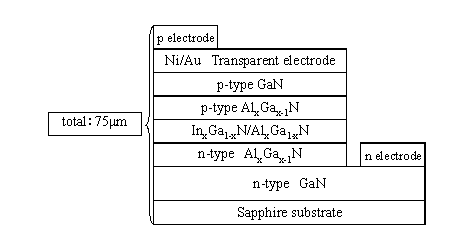Epitaxial Technique
Epiwafers for UV LEDs are made by epitaxial growth in LED structures on sapphire substrates using the method of Metal Organic Chemical Vapor Deposition (MOCVD). The cross-section diagram of a typical LED chip's structure is indicated below.
InGaN layer of epiwafers for blue LEDs emits light. The variation of indium composition gives a variety of the wavelength of light from infrared to UV light. The luminus efficiency is maximized at the wavelength of 400-420nm and it will be deteriorated slowly at the longer wavelength than that and will be deteriorated rapidly at the shorter wavelength than 380nm. GaN's bandgap is 3.4eV(365nm) and which is the shortest wavelength.
To achieve the shorter wavelength of light, a four-mixed crystal of AlInGaN using AlN which has a bandgap of 6.2eV(200nm) are employed.
There are two reasons why the light-emitting efficiency deteriorates at the lower wavelength than 380nm. The first reason is deterioration of non-uniformity in InGaN layer causes the reduction of transforming density. The second one is the absorption the emission at the lower wavelength than 370nm by GaN layer. Therefore to improve t light-emitting efficiency at the shorter wavelength, it is necessary to increase the non-uniformity in the activated layer and to reduce in the dislocation density.



